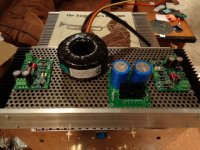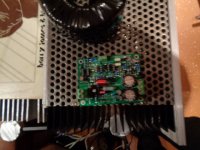Most class AB amps operate in class A at lowish normal listening levels anyway... An LM3886 can make about 65 dB SPL from a 85 dB/W*m efficient speaker before entering class AB.
~Tom
~Tom
Class A with Parallel-86 in bridge mode
How Parallel-86 in bridge mode?
2PCB x 2 => 71 dB SPL?
An LM3886 can make about 65 dB SPL from a 85 dB/W*m efficient speaker before entering class AB.
~Tom
How Parallel-86 in bridge mode?
2PCB x 2 => 71 dB SPL?
Other question:
Why the same Power-86 is used for both? Would not it be more logical to double the capacitance in the Parallel-86?
Other question:
Why the same Power-86 is used for both? Would not it be more logical to double the capacitance in the Parallel-86?
The web site for the Power-86 clearly states:
"The Power-86 Power Supply Board is intended as a companion board for the state of the art Modulus-86 amplifier. The intended use is for one Power-86 board to power two Modulus-86 boards in a stereo amplifier."
It logically follows that a single Power-86 module is enough for a single Parallel-86 module.
It logically follows that a single Power-86 module is enough for a single Parallel-86 module.
Correct. I'd go as far as to recommend one Power-86 board for a stereo Parallel-86. 22000 uF is plenty of capacitance for that.
For a bridged Parallel-86, I'd go with one Power-86 per channel. So two Power-86 boards for a bridged Parallel-86 stereo amp.
Tom
The transformer I have has 16 awg wiring, which does not fit in the PCB. Here is what I have so far. C9 has been changed to a Wima MKS2 63V part, which I see has also been obsoleted.....
So far, I am this far, missing a few connector parts for the power86. My concern whether or not the inductor on the first board ought to be cleaned up...
Thanks!
So far, I am this far, missing a few connector parts for the power86. My concern whether or not the inductor on the first board ought to be cleaned up...
Thanks!
Attachments
Last edited:
Here is the enclosure size. A bit worried about the heatsinks. They are 180 wide, 70 tall with 45mm fins.... The toroid is rated 19.5 VAC, 185 VA. Awaiting parts from Mouser -- the connectors for the power86.
The toroid uses 16awg which does not fit, else I would wire direct.
The toroid uses 16awg which does not fit, else I would wire direct.
Attachments
The transformer I have has 16 awg wiring, which does not fit in the PCB.
Are you sure you are trying to connect the power to the correct terminals on the PCB? The power connectors on the PCB can accept up to AWG 10..
Not on my boards they can't. The power gets connected to the holes that say AC, beside the rectifier. The other side is DC.
If it was bigger, I'd use these instead:
H9026-01 Harwin | Mouser
If it was bigger, I'd use these instead:
H9026-01 Harwin | Mouser
Not on my boards they can't. The power gets connected to the holes that say AC, beside the rectifier. The other side is DC.
If it was bigger, I'd use these instead:
H9026-01 Harwin | Mouser
I see, so your order did not come with the connector as shown here?
An externally hosted image should be here but it was not working when we last tested it.
Nope. I got stung with the Mouser "combine projects bug".
The bug has since been resolved -- mouser promises to waive shipping on the missing parts for me. No one else should have any trouble.
The bug has since been resolved -- mouser promises to waive shipping on the missing parts for me. No one else should have any trouble.
Nope. I got stung with the Mouser "combine projects bug".
The bug has since been resolved -- mouser promises to waive shipping on the missing parts for me. No one else should have any trouble.
Ah I see. Sorry for the sidetrack. I am about to order some Parallel-86 boards so was wondering how it could have gone wrong!
I see Tom has updated his Neurochrome site with the tested figures for the Parallel-86 - looks great! 😀
I see Tom has updated his Neurochrome site with the tested figures for the Parallel-86 - looks great! 😀
Yep. That went up yesterday. I'll add some plots as well. You can find the plots in the Modulus-86 thread (Post #1065-1067).
Tom
Tom, you should update your signature, without /audio
+1 That link doesn't work
Great site though!🙂
Hi,
I am making the RCA version. According to the drawings, the safety earth and the zero volt line are at the same potential.
Would there be any harm/benefit in inserting the "ground loop breaker" found on Rod Elliott's pages between the chassis and the zero volt line instead of wiring the zero volt line directly to the chassis/safety earth?
Earthing (Grounding) Your Hi-Fi - Tricks and Techniques
Thanks.
I am making the RCA version. According to the drawings, the safety earth and the zero volt line are at the same potential.
Would there be any harm/benefit in inserting the "ground loop breaker" found on Rod Elliott's pages between the chassis and the zero volt line instead of wiring the zero volt line directly to the chassis/safety earth?
Earthing (Grounding) Your Hi-Fi - Tricks and Techniques
Thanks.
Tom, you should update your signature, without /audio
Good catch. Thank you. I just moved web host to a faster service. In the process, I removed the /audio. I've updated my signature. Thanks again.
Tom
look at figure4.Hi,
I am making the RCA version. According to the drawings, the safety earth and the zero volt line are at the same potential.
Would there be any harm/benefit in inserting the "ground loop breaker" found on Rod Elliott's pages between the chassis and the zero volt line instead of wiring the zero volt line directly to the chassis/safety earth?
Earthing (Grounding) Your Hi-Fi - Tricks and Techniques
Thanks.
ADD a switch across the Disconnecting Network (DN).
This gives the Builder/user the option to use the DN as the loop resistance or as a direct connection.
In many mono installations the direct connection performs better.
In many multi-channel installations, the optional switch set to open performs better..
if you look back at many of my posts you will see that I often recommended the added switch for the DN. My opinion has not changed. I just get tired of repeating the same information dozens of times.
- Home
- Amplifiers
- Chip Amps
- Modulus-86 build thread



